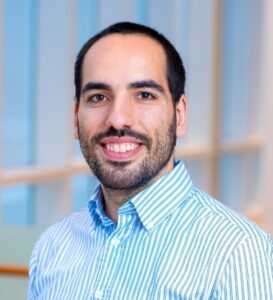
Plasma theorist Rogerio Jorge will join the UW–Madison physics department as an assistant professor on January 1, 2024. He joins us from IST in Lisbon, Portugal, where he is a research professor. Jorge completed his first postdoc at the University of Maryland at College Park, then accepted a Humboldt Fellowship where he worked on the design of fusion energy devices in Greifswald, Germany.
Please give an overview of your research.
My work is twofold: I uncover basic plasma physics phenomena and apply my plasma physics knowledge to the realization of fusion energy. My most recent work is devoted to the design of Stellarators, a type of fusion machine that is free of major instabilities and disruptions. Here, we try to have this clean renewable energy available to the world as fast as possible. While I’ve been doing research on fusion since my PhD studies, where I focused on one type of device called the Tokamak, when I went to the U.S. for my postdoc, I started focusing on the Stellarator. The Stellarator has had a lot of research since the ’60s, but only recently it had a big resurgence.
Thanks to the enormous progress in computational power, I do a lot of simulations for my work. I have worked on several codes, each focusing on a particular physics or engineering problem such as electromagnetic coils, stability, turbulence, and energy retention, which are all used in combination to do designs for new machines. I also collaborate with startups seeking to rapidly develop fusion energy and supervise students and postdocs who are trying to get new designs for new machines. Most of our work is in the realm of classical physics, based on things that people learn while they’re majoring in physics such as electrodynamics and electromagnetism. But then, we couple it with new computational and mathematical techniques, such as machine learning, to streamline our workflow.
We have ideas for Stellarator design that could allow for much better performance than we had before so that the resulting devices achieve higher temperatures and higher densities. However, we should always take into account that theory and experiment may operate on different planes. We are in contact with experimentalists who sometimes tell us, “Your machine is too complicated to build!” And then we have to go back and incorporate their constraints into the design.
Once you arrive in Madison, what are one or two research projects you think your group will focus on first?
Stellarator design and optimization will be one of the main branches, and we have many projects that either could be started or have started in my research group now that we will be continuing in Madison. One of these topics is the confinement of fast particles resulting from fusion reactions, that is, alpha particle dynamics. These must stay confined long enough to continuously feed energy to the plasma, leading to what we call a burning plasma. Right now, the machines we have, they’re still prototypes, meaning that they haven’t made many studies on the physics of burning plasmas. We still need to do a lot of research on it. Once we turn on the machine and start getting a lot of energy, we must be able to predict what’s going on. Burning plasma physics or fast particle physics is one of the major issues. Besides burning plasma physics, I will also continue the work on stellarator optimization, with a particular focus on how machine learning can help us obtain increasingly better designs and how to incorporate experimental constraints into the optimization. Another branch will be the study of basic plasma physics with a particular focus on astrophysical plasmas. During my PhD, I developed a method to accurately incorporate collisions between charged particles in plasmas. I intend to further develop that technique, creating a numerical tool that is easy to use and can be used to predict extreme events in space, as well as predict the behavior of plasmas in the lab, such as the Wisconsin Plasma Physics Laboratory.
What attracted you to Madison?
Madison has one of the best physics departments in the world, particularly in my area of plasma physics. I believe it’s one of the top places that people think of when they do the sort of work that I do, stellarators and basic plasma physics. This is because there is here a prototype fusion device, a myriad of experimental plasma physics facilities, and people doing state-of-the-art theory and simulation. Furthermore, when I visited Madison, I loved the views, the lakes, and the overall quality of life.
What is your favorite element or elementary particle?
I think I like the neutrino. It was fun learning about neutrinos in particle physics. They were thought to have no mass, but their flavors can actually oscillate while they travel, and this yields a very tiny but finite amount of mass. Besides, they can go through essentially everything without getting detected, they’re basically invisible! It’s something that you think you know what it is, and you know all the calculations and you understand it, but at the end of the day experiments and the nature tells you that you don’t exactly know what you think you know. There’s more to the story there and they seem so simple, yet there is more to the story.
What hobbies and interests do you have?
Definitely music. I play the guitar and I like to learn how to play new instruments. I have a few instruments around the house but the one that I am learning how to play right now is the violin. Like the neutrino, even with only four strings, it’s a deceivingly complicated instrument.